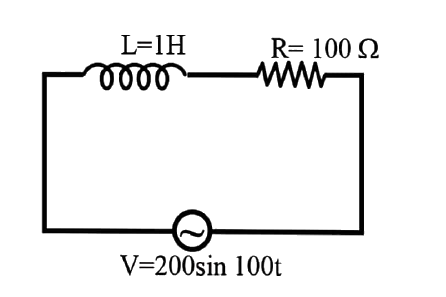In the adjacent circuit, the instantaneous current equation is

The correct Answer is:B
Step by step video & image solution for In the adjacent circuit, the instantaneous current equation is by Physics experts to help you in doubts & scoring excellent marks in Class 12 exams.
Updated on:21/07/2023Similar Questions
In the given A.C. circuit, the instantaneous current through inductor and capacitor are 0.8 A and 0.4 A repectively. The instantaneous current through resistor is

View SolutionIn an AC series circuit, the instanctaneous current is zero when the instantaneous voltage is xamimum. Connected to the source may be a
View SolutionIn an ac circuit the instantaneous values of current and applied voltage are respectively i=2(Amp)sin(250πs−1tandε=(10V)sin[(250πs−1)t+π3, Find the instantaneous power drawn from the source at t=23ms and its average value.
View SolutionIn an ac circuit the instantaneous values of current and applied voltage are respectively i=2(Amp)sin(250πs−1tandε=(10V)sin[(250πs−1)t+π3, Find the instantaneous power drawn from the source at t=23ms and its average value.
View SolutionIn an a.c. circuit, the instantaneous e.m.f. and current are given by e = 100 sin 30 t
i=20sin(30t−π4) In one cycle of a.c., the average power consumed by the circuit and the wattless current are, respectively :
View SolutionIn an a.c. circuit, the instantaneous e.m.f. and current are given by e = 100 sin 30 t
i=20sin(30t−π4) In one cycle of a.c., the average power consumed by the circuit and the wattless current are, respectively :
View SolutionThe circuit shown in the figure is a series LCR circuit connected to an AC source. This circuit has many important applications in practical electronic systems. In the given circuit, L=20mH and frequency of applied alternating potential difference is ω=8000rad/s. Initial phase of applied potential difference has such a minimum value that initial value of instantaneous potential difference is half of is peak value while initial phase of current in the circuit has such a minimum value that initial value of instantaneous current equals its peak value. We also observe that current in the circuit leads the net voltage across the circuit. It is given that peak values of potential difference across R and L are I VR(peak))=25V
V(L)peak=20V

Instantaneous current in the circuit is
View SolutionThe circuit shown in the figure is a series LCR circuit connected to an AC source. This circuit has many important applications in practical electronic systems. In the given circuit, L=20mH and frequency of applied alternating potential difference is ω=8000rad/s. Initial phase of applied potential difference has such a minimum value that initial value of instantaneous potential difference is half of is peak value while initial phase of current in the circuit has such a minimum value that initial value of instantaneous current equals its peak value. We also observe that current in the circuit leads the net voltage across the circuit. It is given that peak values of potential difference across R and L are I VR(peak))=25V
V(L)peak=20V

Instantaneous value of potential difference applied
View SolutionThe circuit shown in the figure is a series LCR circuit connected to an AC source. This circuit has many important applications in practical electronic systems. In the given circuit, L=20mH and frequency of applied alternating potential difference is ω=8000rad/s. Initial phase of applied potential difference has such a minimum value that initial value of instantaneous potential difference is half of is peak value while initial phase of current in the circuit has such a minimum value that initial value of instantaneous current equals its peak value. We also observe that current in the circuit leads the net voltage across the circuit. It is given that peak values of potential difference across R and L are I VR(peak))=25V
V(L)peak=20V

Value of instantaneous potential differenc across resistance R is
View SolutionThe circuit shown in the figure is a series LCR circuit connected to an AC source. This circuit has many important applications in practical electronic systems. In the given circuit, L=20mH and frequency of applied alternating potential difference is ω=8000rad/s. Initial phase of applied potential difference has such a minimum value that initial value of instantaneous potential difference is half of is peak value while initial phase of current in the circuit has such a minimum value that initial value of instantaneous current equals its peak value. We also observe that current in the circuit leads the net voltage across the circuit. It is given that peak values of potential difference across R and L are I VR(peak))=25V
V(L)peak=20V

Instantaneous potential difference across the inductor can be expressed as
View Solution
